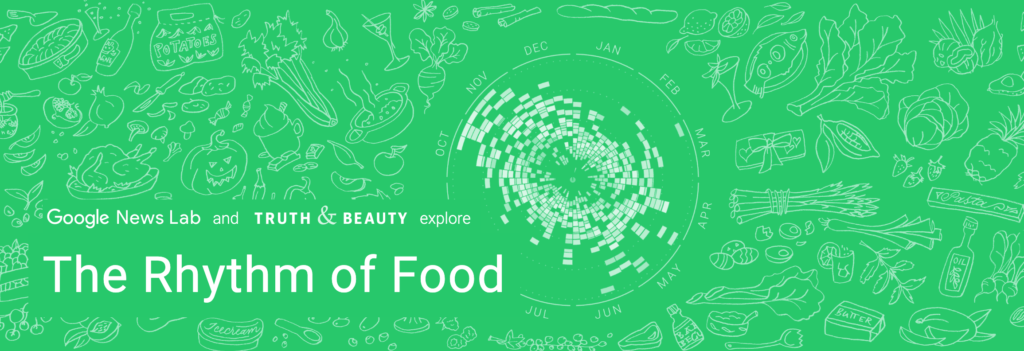The Rhythm of Food is a project that analyzes the trends of different foods and ingredients in the year. The project started by collecting and analyzing the dynamics of Google search interest of recipes over diets and cuisines to reveal the food trend. Later, the team applied this research method toward food ingredients. After analyzing the trends of dishes, they found patterns of food ingredients over 15 years. They present the outcome in a year clock, where users can move their mouse and see the trend score of the component in different months and years.
- Sources: The Google search data comes from Google Trends. They collected weekly data from Google Trends for Hundreds of dishes and ingredients over 15 years.
- Processes: They categorized the Google Trends score by the food ingredients, the month of the year, and even countries and then entered the data into a spreadsheet.
- Presentation: Each ingredient uses a year clock to show the Google Trends score in different months and years. They also make the year clock interactive. Users can also search for the ingredients they are curious about.

New Question:
Can we apply this analysis to other industries like the medical or clothing industries?
Discussion Questions:
Who is the target audience?
This project helps users find patterns and trends of the food ingredients over the year. As for the broader public, however, people cannot do anything with the data except play with it. I think the target audiences are restaurant and food industry managers, farmers, and cooking vloggers since they all need data support for their decisions on updating the menu, video making, and so on.
Does the site make an argument? If so, what?
The site gives out some common patterns of food trends, such as trends based on seasons and holidays or special events. Also, trends in food might be different in different countries. In addition, since the site provides visualized data, it is simple and effortless for the users to come up with their arguments about the trends of the ingredients they are interested in.
1 thought on “Reverse Engineering “The Rhythm of Food””
Comments are closed.

You gave a clear introduction and analysis of the project. When I explored the same project in class, I also came up with the question of whether this kind of analysis could be applied to other industries. Since this is collaborated with Google analytics, I wonder if one of the aims is for Google to promote how powerful their search data is and encourage more similar analysis. I agree with you that the general public might only be able to view/play with the project. Yet it’s a fun website!